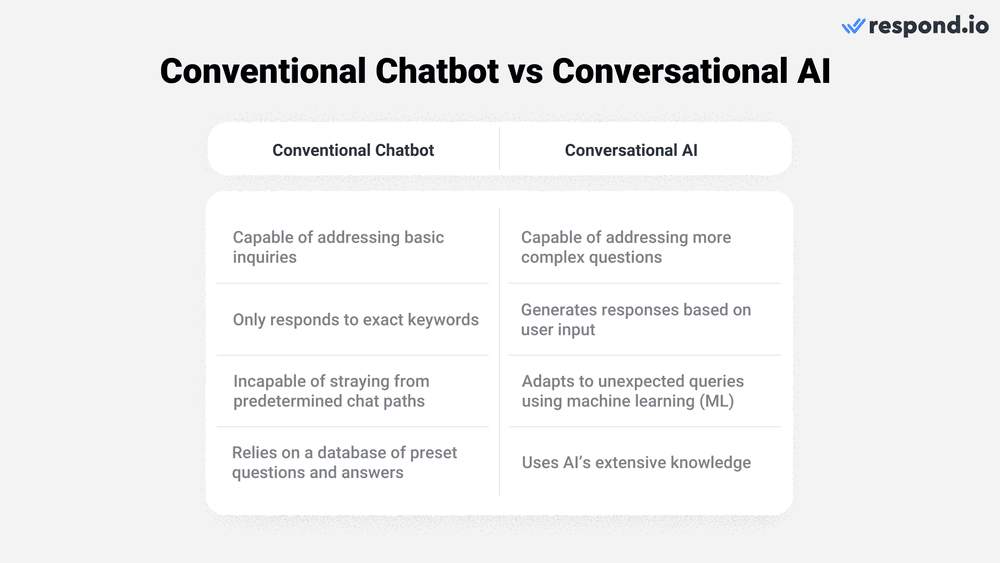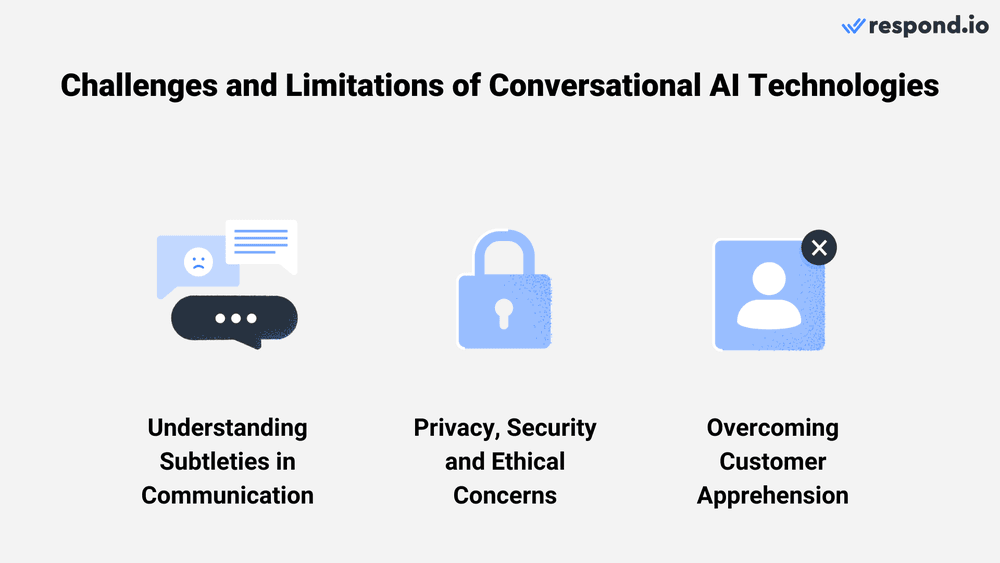Conversational AI has entered the chat and is here to redefine customer conversations. Thanks to its advanced capabilities, automated conversations that used to be rule-based and scripted have become dynamic and intuitive. But what does this mean for businesses?
This guide will walk you through everything you need to know about conversational AI for customer conversations. You'll learn what it is, how it works and its differences from conventional chatbots. Then, we’ll explore how it's redefining customer conversations, ways to implement it and best practices for using it effectively.

What is Conversational AI?
Conversational artificial intelligence (AI) refers to the use of AI technologies to simulate human-like conversations. It uses large volumes of data and a combination of technologies to understand and respond to human language intelligently.
The best part is that the AI learns and enhances its replies from every interaction, much like a human does. Some rudimentary conversational artificial intelligence examples you may be familiar with are chatbots and virtual agents.
Before exploring how this technology has evolved, let’s look at how advanced conversational AI works.
How does Conversational AI Work?
Conversational AI combines technologies like natural language processing (NLP) and machine learning (ML) to help software systems mimic human interactions.
NLP equips these systems with the ability to understand, interpret and generate human language. It translates the nuances of human conversations into a language that software can understand, enabling it to interact with humans more naturally.
Meanwhile, ML empowers these systems to learn and improve from data and experiences. It analyzes conversation patterns and uses these insights to make informed predictions and decisions. As these systems process and analyze more data, their ability to make accurate predictions enhances over time.
These two technologies feed into each other in a continuous cycle, constantly enhancing AI algorithms. Here’s an example of how it works for customer conversations.

Let's say a customer inquires about your product on WhatsApp. First, the AI reads the message, analyzes it and understands what the customer is really looking for.
Then, it comes up with a reply based on its understanding. It's not just spitting out pre-written answers; it's crafting responses on the spot. While interacting with customers, it learns from their responses to enhance its accuracy over time.
Now that you know how it works, we’ll answer a popular question: What makes conversational AI different from conventional chatbots?
Conventional Chatbot vs Conversational AI
To put it simply, today’s conversational AI technologies are a significant evolution from conventional chatbots.
Traditional chatbots operate based on pre-defined rules and scripts, so their responses are limited to a narrow range of inputs. They can easily handle straightforward, predictable questions but struggle with complex or unexpected requests.
Conversational AI, employing advanced technologies like ML and NLP, dynamically generates responses based on user input rather than being restricted to a set script. It draws answers from the AI's extensive knowledge base to handle a broader range of topics and adapt to ambiguous or context-heavy questions.

Additionally, AI systems are more adept at recognizing and adapting to various linguistic nuances, such as slang, idioms or regional dialects. This gives it the ability to have more human-like interactions.
In summary, while conventional chatbots are rule-based and limited in scope, conversational AI systems offer a more flexible and adaptive approach, delivering a conversational experience similar to human interaction.
So, do businesses need conversational AI for customer conversations? We’ll explore the answer in the next section.
Why Conversational AI is Revolutionizing Customer Conversations
Before jumping into the benefits of conversational AI, you must first understand its significance in customer communications. Today, customer conversations can occur across various channels, including phone calls, emails and messaging apps.
With the growing preference for messaging apps over emails or calls, these channels have presented opportunities for businesses to engage, delight and convert. In fact, a study reveals that 75% of customers make a purchase after chatting on a messaging app, highlighting its effectiveness as a tool for conversion.
“While messaging channels offer numerous opportunities, businesses often hesitate to use them as part of their customer strategy. This is because handling high volumes of conversations can be challenging, and they don’t want to sacrifice service quality.
This is where conversational AI adds value by providing prompt, high-quality responses at a much larger scale and lower cost,” said Gerardo Salandra, the co-founder and CEO of respond.io, also chairman of The Artificial Intelligence Society of Hong Kong.
With this understanding, let's explore in more detail how conversational AI can substantially benefit your business.
Benefits of Conversational AI
Gartner predicts that by 2026, one in 10 agent interactions will be automated and conversational AI deployments within contact centers will reduce agent labor costs by $80 billion.
Imagine a team of 10 agents dedicated to providing high-quality responses yet constrained to handling a handful of conversations simultaneously. Implementing conversational AI transforms this scenario dramatically.
Unlike human agents, conversational AI operates round the clock, providing constant support to customers globally, irrespective of time zones. Plus, its ability to translate and respond in multiple languages extends its global reach, breaks down language barriers and broadens the customer base.
Best of all, the AI does all these while maintaining high-quality responses on a much larger scale. It can handle hundreds of conversations simultaneously, more efficiently and at a reduced cost.

Supporting this narrative, a study reveals that half of 300 surveyed contact center and IT leaders reported conversational AI has helped decrease operational costs.
As the AI manages up to 87% of routine customer interactions automatically, it significantly reduces the need for human intervention while maintaining quality on par with human interactions. This efficiency led to a surge in agent productivity and quicker resolution of customer issues.
Evidently, this trend transcends cost reduction. It significantly enhances efficiency in managing high volumes of conversations and helps agents manage high-value conversations effectively.
Additionally, combining AI and human agents ensures that customer interactions are empathetic and personalized. As customers receive swift and precise responses that meet their needs, businesses can improve customer satisfaction and boost conversion rates.
This, in turn, gives businesses a competitive advantage, fostering growth and outpacing their competitors. Having discussed the benefits, let's explore challenges and limitations.
Challenges and Limitations of Conversational AI
Incorporating conversational AI into customer interactions presents several challenges despite its potential to streamline communication.
A significant limitation is AI's difficulty grasping human communication nuances like sarcasm, cultural context and emotional tone. This becomes particularly evident in situations requiring high emotional intelligence, where human oversight is indispensable.

Besides that, relying on extensive data sets raises customer privacy and security concerns. Adhering to regulations like GDPR and CCPA is essential, but so is meeting customers' expectations for ethical data use. Businesses must ensure that AI technologies are legally compliant, transparent and unbiased to maintain trust.
Customer apprehension also poses a challenge, often from concerns about data privacy and AI’s ability to address complex queries. Mitigating this requires transparent communication about AI capabilities and robust data privacy measures to reassure customers.
Now that you have all the essential information about conversational AI, it’s time to look at how to implement it into customer conversations and best practices for effectively utilizing it.
How to Use Conversational AI for Customer Conversations
Integrating conversational AI into customer interactions goes beyond simply choosing an appropriate platform — it also involves a range of other essential steps.

The journey involves five key stages:
- Identify business objectives
- Research the capabilities you need
- Ensure compatibility with your existing tech stack
- Choose the right AI platform
- Train AI to align with your objectives
Let's explore how to navigate these stages for successful conversational AI implementation.
Identify Your Objectives
Start by clearly defining the specific business objectives you aim to accomplish with conversational AI. Pinpoint areas where it can add the most value, be it in marketing, sales or customer support.
For instance, your goals can include managing high volumes of conversations automatically, enhancing customer interaction, efficient case resolution, personalizing purchase journeys, accurate information delivery and more.
Your objectives will serve as a roadmap for selecting the right AI tools and tailoring them to your specific needs. With your goals clearly defined, the next step is to research the specific capabilities your conversational AI platform needs to possess.
Research and Identify the Capabilities You Need
Based on your objectives, consider whether conventional chatbots are sufficient or if your business requires advanced AI capabilities. Note that some providers might label traditional chatbots as “AI-powered” despite lacking technologies like NLP and ML.
Some capabilities conversational AI brings include tailoring interactions with customer data, analyzing past purchases for recommendations, accessing your knowledge bases for accurate responses and more.
Once you clearly understand the features you need, one crucial factor to consider before choosing a conversational AI platform is its compatibility with your current software stack.
Evaluate Compatibility with Existing Tech Stack
When considering a conversational AI platform, ensure it can integrate seamlessly with your existing software, such as your CRM or e-commerce platforms. This ensures a smooth workflow and prevents integration issues.
Once you clearly understand your needs and how they fit with your current systems, the next step is selecting the best platform for your business.
Choose the Right Conversational AI Platform
Selecting the right conversational AI platform is critical as your business will rely heavily on it for managing customer conversations. If your business is growing quickly, look for a solution that is scalable and adaptable to future needs and technological advancements.
The right platform should offer all the features you need, ease of integration, robust support for high conversation volumes and flexibility to evolve with your business.
Most importantly, the platform must adhere to global data protection regulations like GDPR and CCPA, ensuring robust data privacy and security. With the right platform chosen, the next step is to focus on training your AI.
Train AI to Align with Your Business Objectives
Depending on your chosen platform, you can train your AI Agent to mirror the efficiency of your best human agents. You can integrate AI into current workflows, enabling it to serve as an initial responder to handle routine inquiries and direct more complex or sensitive conversations to human agents.
Additionally, training your AI to provide accurate responses is crucial. This involves supplying it with up-to-date information, often sourced from existing resources like your knowledge base articles or FAQs. This ensures the AI remains relevant and effective in addressing customer inquiries, ultimately helping you achieve your business goals.
Now that you know what you need to implement conversational AI into customer conversation, let’s look at some best practices.
Best Practices for Using Conversational AI
Incorporating conversational AI into your customer service strategy can significantly enhance efficiency and customer satisfaction.

However, to get the most out of this technology, it's important to follow certain best practices.
Match AI’s Personality to Your Brand’s Tone
By aligning the AI's personality with your brand's tone, you enhance the customer experience, making conversations feel more personal and relatable. This approach not only reinforces your brand identity but also fosters a stronger connection with your audience.
Having matched the AI’s personality to your brand’s tone, let’s now explore another crucial best practice: continuous evaluation and education.
Continuously Evaluate and Educate Your AI
The efficacy of conversational AI depends on its ability to learn and adapt. Continuously evaluate its performance to ensure it's achieving your objectives and keep it updated with new information.
Regular updates to its knowledge ensure that the AI remains relevant and effective in handling diverse customer interactions. This ongoing evaluation and education process is critical, but it's also important to recognize situations where human intervention is more appropriate.
Know When to Escalate to Human Agents
Despite the sophistication of AI, certain complex or sensitive issues may require human intervention. Incorporate a seamless escalation pathway to human agents in such scenarios, ensuring that the transition is smooth and that the agents have quick access to the context of the interaction.
This leads to the next best practice – training human agents to leverage AI tools.
Train Human Agents to Leverage AI
Based on the features of your selected platform, you can provide agents with sophisticated AI tools to enhance their interactions with customers. Let’s take respond.io as an example.
Respond AI Prompts can help agents refine their messages, ensuring clarity and precision in communication. They can also translate messages into different languages, reducing potential language barriers.
Moreover, tools like AI Assist can be a game-changer for providing agents quick access to relevant information. This rapid access to information allows agents to respond quickly and accurately to customer inquiries, enhancing response times and contributing to a more satisfying customer experience.
Key Takeaways
Conversational AI stands at the forefront of a new era in customer engagement, offering a revolutionary shift from traditional communication methods.
As we've explored in this guide, integrating advanced conversational AI technologies empowers businesses to conduct more dynamic, intuitive and personalized customer interactions. Unlike conventional chatbots, they offer a depth of understanding and adaptability, allowing for conversations that truly resonate with customers.
While this transformative technology is not without its own challenges, the trajectory of conversational AI is undeniably upward, continually evolving to overcome these limitations.
“AI is finally at the stage where businesses can maintain service quality at a significantly larger scale and with reduced costs. Therefore, companies that adopt this first will have a massive advantage over their competitors,” said Gerardo Salandra.
In a world where customer expectations constantly escalate, sticking to traditional methods could lag a business. Conversational AI is not just a tool for the present but an investment for a future where seamless, intelligent and empathetic customer interactions are the norm.
Frequently Asked Questions
What is conversational AI?
Conversational AI is a type of artificial intelligence (AI) that can simulate human conversation. It is made possible by natural language processing (NLP), a field of AI that allows computers to understand and process human language and Google's foundation models that power new generative AI capabilities.
What is the future of conversational AI?
The future of this technology lies in becoming more advanced, human-like, and contextually aware, enabling seamless interactions across various industries. We have a dedicated blog that brings some light to this exciting question.
How do I plan for a conversational AI strategy?
Start by defining clear goals and target audiences, then choose the right technology and platforms aligned with your objectives. Next, use engaging and context-aware dialogue flows, and continually test and refine based on user feedback and interaction data.
What should I look for in a conversational AI software?
Look for the ability to integrate with your existing systems. It's also crucial to consider user experience, customization options and the software's scalability to adapt to growing business needs.
Need guidance on selecting the best conversational AI platform for your business? Our detailed article will provide the insights you need. And if you're ready to embark on enhancing customer conversations with AI, start your journey with respond.io, an AI-powered customer conversation management software – try it for free today!

Further Reading
If you want to learn more about conversational artificial intelligence for customer conversations, here are some articles that might interest you.
- Conversational Artificial Intelligence Platform: How to Choose One
- AI Customer Service: The Next Age of Customer Support
- Conversational Artificial Intelligence for Sales: A How-to Guide



























